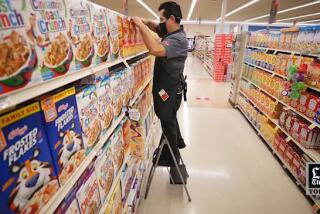Economy Grows at Slow 0.4% Rate in Second Quarter
The nation’s economy began to limp out of recession in the second quarter, expanding at an anemic 0.4% annual rate after two consecutive quarters of shrinkage, the Commerce Department reported Friday.
The report confirmed a growing consensus that the recession hit bottom last spring. But the weakness of the rebound, which was only half as strong as private analysts had expected, revived fears that the recovery will be very weak or very short-lived.
The economy’s slight uptick in the April-June quarter followed a 2.8% annual decline in the first quarter of 1991 and a 1.6% shrinkage in the final quarter of 1990. The two declines ended nearly eight years of steady growth in the gross national product, the government’s estimate of the total value of all goods and services produced in America.
White House economic adviser Michael J. Boskin was cautiously upbeat about the second-quarter figures, pronouncing the weak uptick “exactly what we forecast.” Commerce Department Chief Economist J. Antonio Villamil characterized the report as “welcome news” that indicated the recovery would be sustained in coming months.
Boskin said the White House now estimates that the gross national product will grow only 0.8% this year, which would represent the continuation of a very modest rebound from what seems to have been an unusually shallow recession.
Private-sector economists, however, clearly were disappointed in the second-quarter report, a preliminary estimate that is subject to later revision. Several cited the possibility of a “double-dip” recession, in which an initial contraction is followed by a brief recovery, only to give way to a second downturn.
“Some will look at this and say it’s a lot like the second quarter of 1982, when GNP rebounded, but then the recession resumed,” said economist Giulio Martini of Sanford C. Bernstein & Co. in New York. “There is grist for the mill here for double-dippers, but I think they’ll be wrong eventually.”
On a more positive note, the GNP report showed a sharp moderation in inflation, which fell from a 5.2% annual rate in the first quarter to a 3% annual rate in the second.
“We are crawling out of a hole, not rebounding,” said economist Allen Sinai of the Boston Co. “The best sign here is low inflation. Business still doesn’t see much recovery here, and if it is recovery, it will be nothing to write home about.”
Even so, Sinai said he believes that chances the economy will slide back into negative territory in the current quarter are no greater than “one in four, or one in five.”
Consumer spending, which had declined in the two previous quarters, increased at a brisk 3.7% annual rate, adding $23.5 billion in inflation-adjusted dollars to estimated annual GNP growth in the second quarter.
That burst of consumption dwarfed the net annual GNP growth of $4.3 billion. But it was swamped by an equally huge, and equally unexpected, $25.7-billion annual decline in the nation’s trade balance after two quarters of strong improvement.
Exports of goods and services improved at a respectable 3.7% annual rate, or $5.9 billion. But imports ballooned at a 21.2% annual rate, or a staggering $31.6 billion, attributable in part to an accounting quirk that inflates the value of inflation-adjusted petroleum imports when oil prices fall, as they did in the second quarter.
Part of the increase in imports also reflected the boom in consumer spending, which some economists believe cannot be repeated later on.
“People seeing a double-dip here are saying that the increase in consumption is a one-time adjustment from recessionary lows that is unsustainable in the future,” said Jerry Jordan of First Interstate Bancorp in Los Angeles. “I think the economy is more resilient than that.”
The consumption boom, moreover, contributed to a big drop in the rate at which retailers, especially car dealers, were reducing inventories--from a $24.7-billion annual rate of liquidation in the first quarter to a $2.6-billion decline in the second quarter.
But wholesalers and durable goods manufacturers stepped up their rate of inventory depletion in the second quarter, so overall inventories dropped by only slightly less in the second quarter than the first. The decline in the level of inventory depletion contributed $3.8 billion to the increase in GNP in the second quarter.






